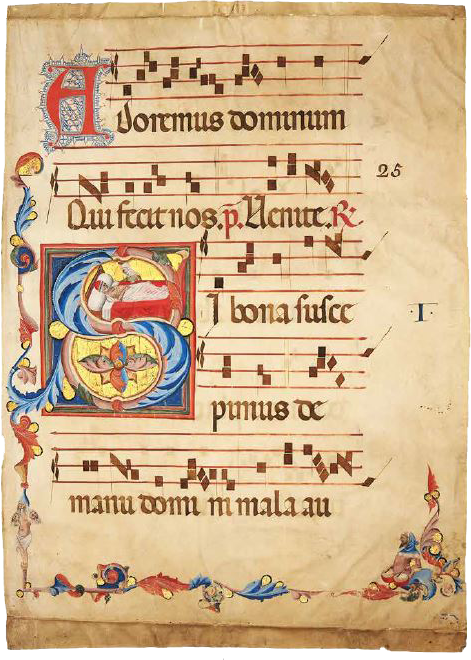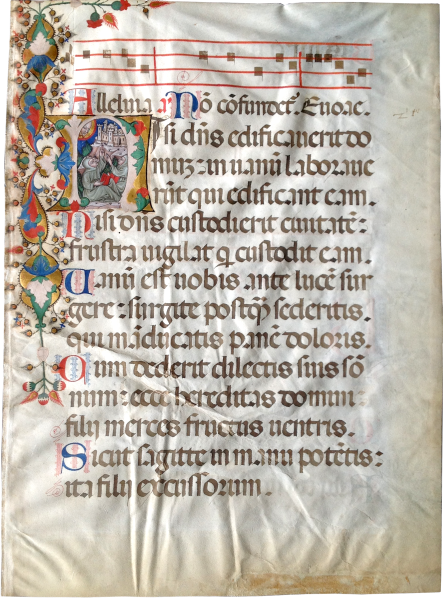Secondo Maestro del Breviario Strozzi Job in Bed Visited by his Wife



Secondo Maestro del Breviario Strozzi 11 (active Tuscany, c. 1340-1350)
, c. 1340-1350

Secondo Maestro del Breviario Strozzi 11 (active Tuscany, c. 1340-1350)
Description
Painted on this leaf from an enormous Choir Book is a miniature showing the suffering Job reclined in bed with sores covering his body, his lower half partly wrapped in a diaphanous sheet, all contained in the upper half of a large initial ‘S.’ Throughout the biblical account of Job’s many afflictions he never wavered in his faith, even when disparaged by his wife, who is shown in the miniature at his bedside (detail 1). The initial is decorated with brightly colored foliates, the lower half of the initial with a single large fleuron set on a gold ground, with a distinctive multicolor frame and sprays of foliates into the borders. The initial ‘S’ opens the chant Si bona suscepimus de manu domini (If we have received good things at the hand of God), a response for the Office of the Dead.
Fantastic human-hybrid figures with bearded faces inhabit the margins, at left with a column figure set inside the scrolling bar motif with three bearded faces atop its torso, and at lower right a musician playing two kettle drums slung around the hips with two bearded faces below the waist spewing foliates (one defaced). Confined to the margins, this rare depiction of kettle drums (detail 2, also called nakers or naccheroni in Italian) vividly evokes the secular music of Italian courts and city streets in bold counterpoint to the sacred music sung out loud from Choir Books.
Previously unknown and apparently unpublished, this leaf belongs to a dismembered Antiphonal made for the church of San Francesco in Pisa. A handful of sister leaves are found in European collections, some dispersed from the Toscanelli collection in Florence in 1883, including a sister leaf with the Coronation of St. Louis of Toulouse in an initial ‘E’ in La Spezia (figure 1; see Sister leaves). A sister leaf with Saint Peter and an Apostle in an initial ‘E’ and similar bearded human-hybrids in the margins surfaced in London in 1990 (figure 2). Six complete Choir Books originally from San Francesco survive at the Museo Nazionale di San Matteo (Cor. A, B, D, E, and F). One Antiphonal (presumed to be Cor. C from this group) with miniatures attributed to the Secondo Maestro del Breviario Strozzi 11 survives in Bethlehem, Pennsylvania (figure 3, Lehigh University, Cod. 25). Twelve related leaves from the same series of Choir Books, with three leaves attributed to our artist by De Benedictis, are in Oxford (Bodleian Library, MS Don. a. 11).
Linked to a group of artists in Pisa historically associated with the celebrated painter Francesco Traini, the artist has been named the Secondo Maestro del Breviario Strozzi 11 for contributions to a Breviary made in Florence in 1326 (Biblioteca Laurenziana, MS Strozzi 11). The artistic personalities associated with this illuminated Breviary were discussed in 1965 by Millard Meiss, who grouped them “in the shadow of Traini.” The attribution to the Secondo Maestro del Breviario Strozzi 11 and the most comprehensive study of the parent Antiphonal is published by Cristina De Benedictis (1979, 1996). The group of artists was studied more recently by Francesca Pasut, who proposed joining the artistic personality of the Second Master of the Breviary Strozzi 11 to that of the Secondo Maestro dell’officina miniatoria trainesca and also the Master of Pisa, Bibl. Capitolare Cor. E.8 (2010, pp. 67-68), imparting a substantial body of work to our anonymous artist’s hand, including a copy of Dante’s Divine Comedy in Berlin (Staatsbibliothek zu Berlin, MS Ham. 203). Our artist’s delightful and inventive borders compare to a celebrated copy of Dante’s Divine Comedy by a contemporary illuminator (figure 4, Rome, Vatican City, BAV Vat. lat. 3199). Considering our artist also illuminated a copy of the Divine Comedy, the column figure in the margin of the present leaf perhaps stands as a manifestation of the Classical world that increasing loomed in the imagination of Renaissance humanists and artists across Italy.
The leaf with five registers of square notation on 4-line staves in red (rastrum 48 mm.) written in a Gothic rotunda (written space 445 x 300 mm.), rubrics in red, a tall initial ‘A’ in red with refined blue and red penwork, Roman numerals “I” in right margin and faint “XIII” on top flap, with later pagination “25” and “26” (recto/verso) in ink; the verso continuing the chant Si bona suscepimus, ending imperfectly “...fac/tum est sit nom(en) do[...].” The miniature and borders with some loses of pigment, especially at edges, the parchment leaf formerly folded at the upper and lower edges, with firm creases, cockling, and some staining, with fragments of a rectangular blue-bordered label in lower right corner, illegible but perhaps partly inscribed “44[...].”
Sister leaves:
Coronation of St. Louis of Toulouse, initial ‘E,’ La Spezia, Museo Civico Amedeo Lia (formerly Toscanelli Collection, Pisa, sold 1883, and Amati Collection, London, sold 1980; see C. De Benedictis 1996; figure 1)
Saint Peter and an Apostle, initial ‘E’ (London, Sotheby’s, 19 June 1990, lot 34; figure 2)
Two Martyrs, London, Wallace Collection, MS 346
Provenance:
From an Antiphonal made for the church of San Francesco in Pisa c. 1330-1340, dismembered in the eighteenth century, perhaps from the Toscanelli Collection, Pisa, sold 1883 (other miniatures appearing in G. Milanesi, Galerie de M. le Chev. Toscanelli de Florence, 1883, nos. 552-553); unidentified collection (from fragmentary label).
Literature:
Unpublished; for the artist, associated group, and parent manuscript, see:
M. Salmi, “Un manoscritto miniato e un problema attributivo,” Commentari. Rivista di critica e storia dell’arte 5 (1954), pp. 14-25 (for the First and Second Masters of the Breviary Strozzi 11)
G. Dalli Regoli, Miniatura Pisana del Trecento, Vicenza, 1963.
M. Meiss, “An Illuminated Inferno and Trecento Painting in Pisa,” The Art Bulletin 47, no. 1 (1965), pp. 21-34.
C. De Benedictis, “Sullo scriptorium pisano del Breviario Strozzi 11,” in La miniatura italiana in età romanica e gotica, Atti del I Congresso di Storia della Miniatura Italiana, Florence, 1979, pp. 489-499.
C. De Benedictis, catalogue entry in F. Todini, ed., Miniatura: La Spezia, Museo Civico Amedeo Lia, La Spezia, 1996, no. 47, pp. 232-238.
C. Balbarini, “Gli Antiphonari del Convento di San Francesco,” in Miniatura a Pisa nel Trecento: dal “Maestro di Eufrasia dei Lanfranchi” a Francesco Traini, Pisa, 2003, pp. 57-113.
F. Pasut, “In the shadow of Traini”? Le illustrazioni di un codice dantesto a Berlino e altre considerazioni sulla miniatura pisana del Trecento,” Predella 1 (2010), pp. 55-78, pls. XV-XXVII.
Online resources:
Bodleian Library, MS Don. a. 11
